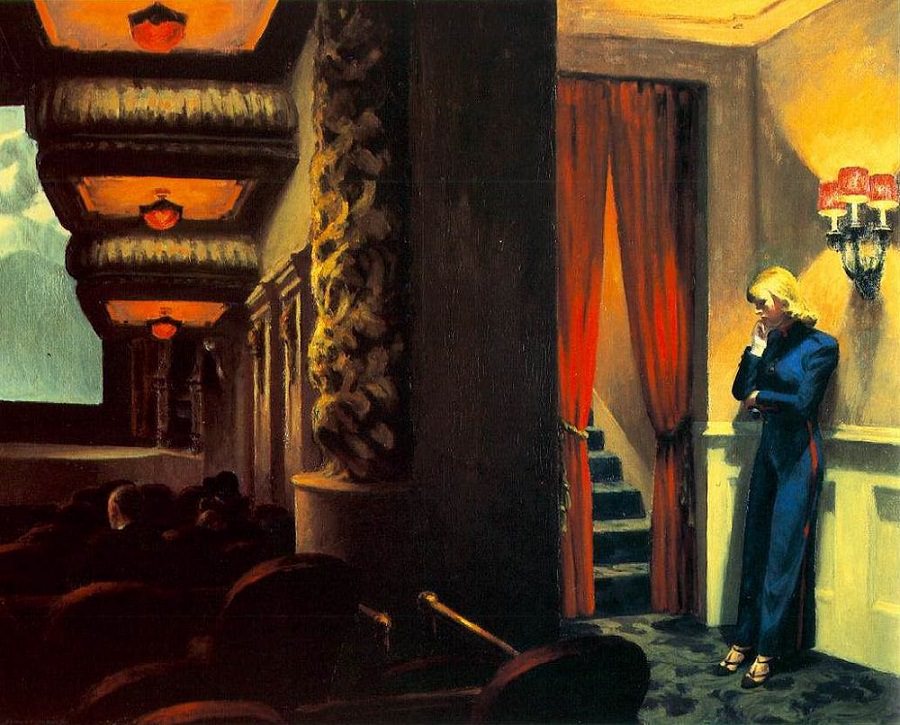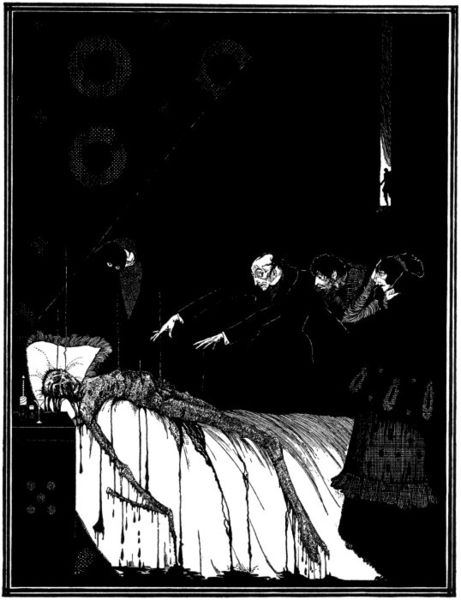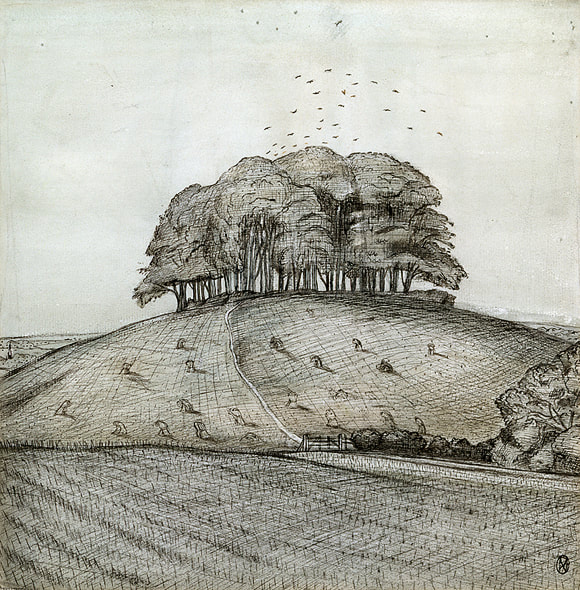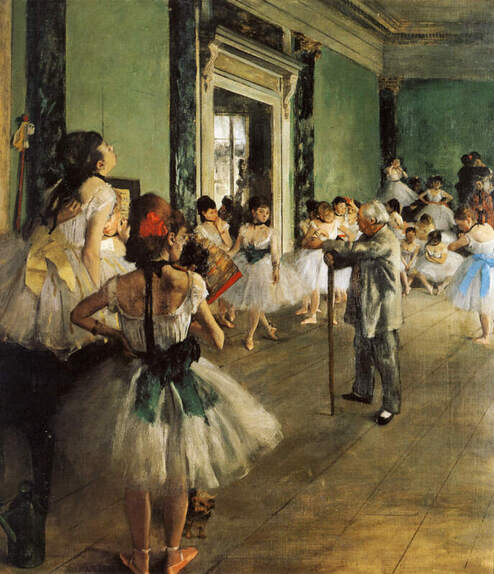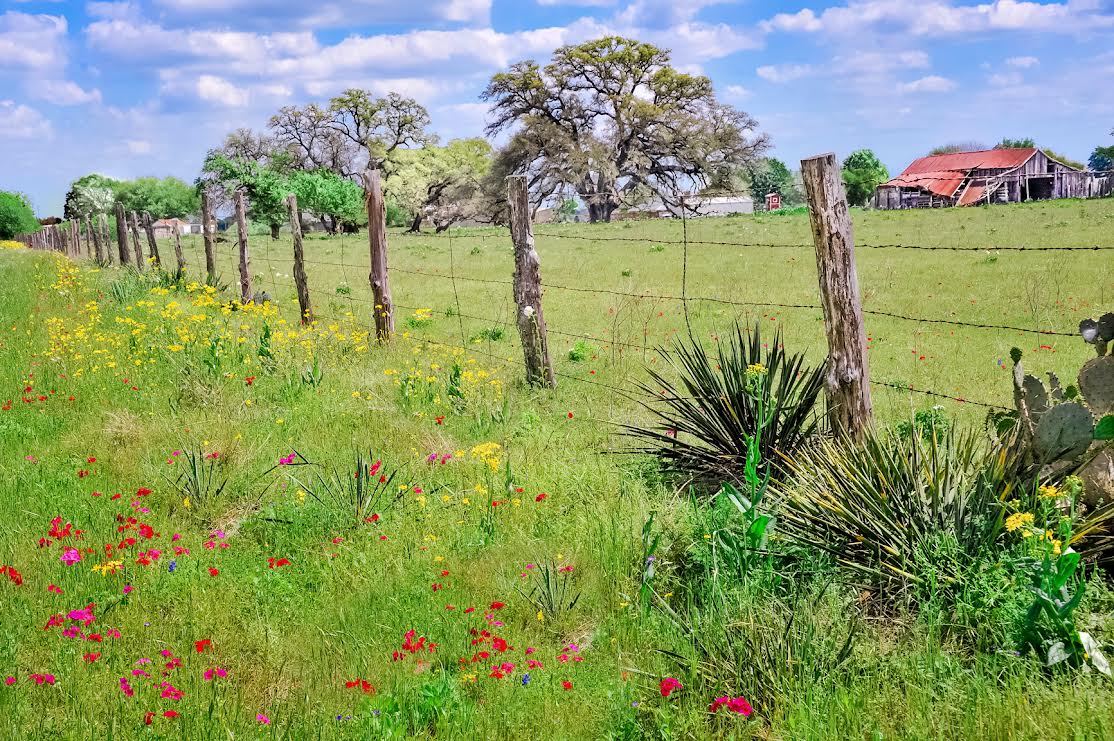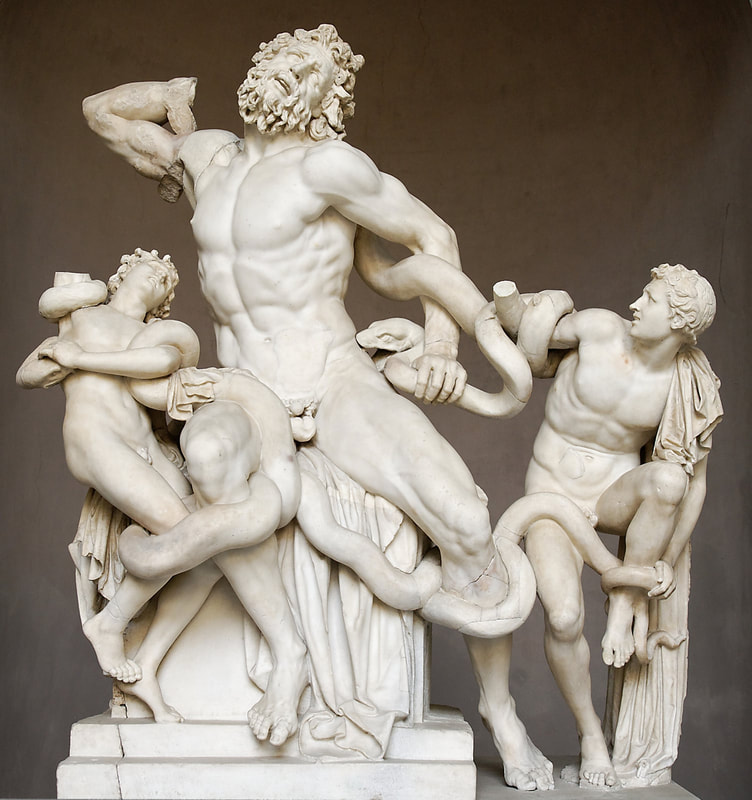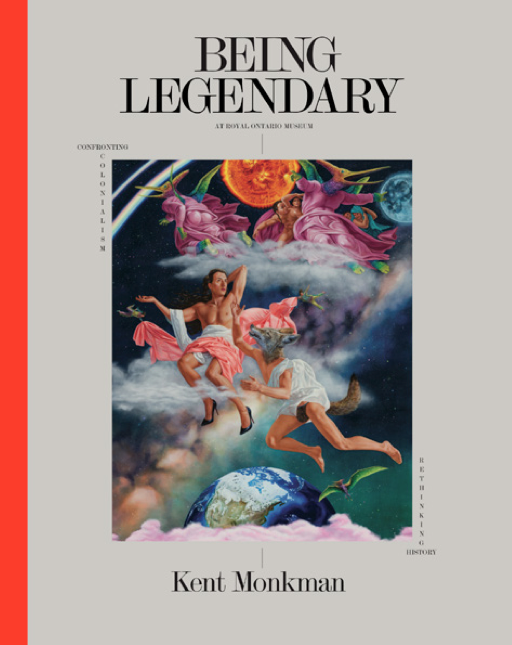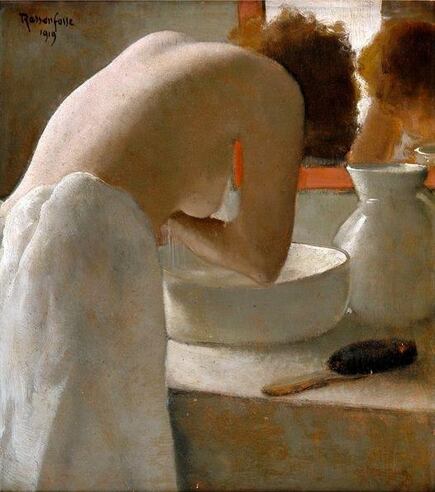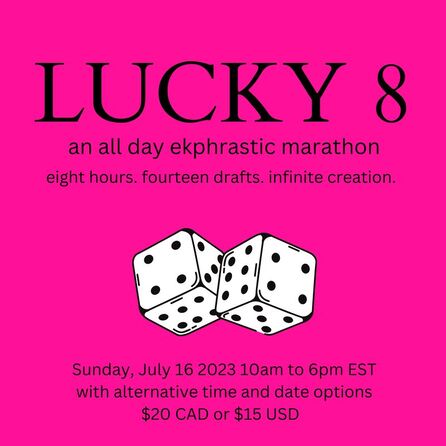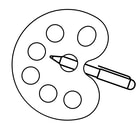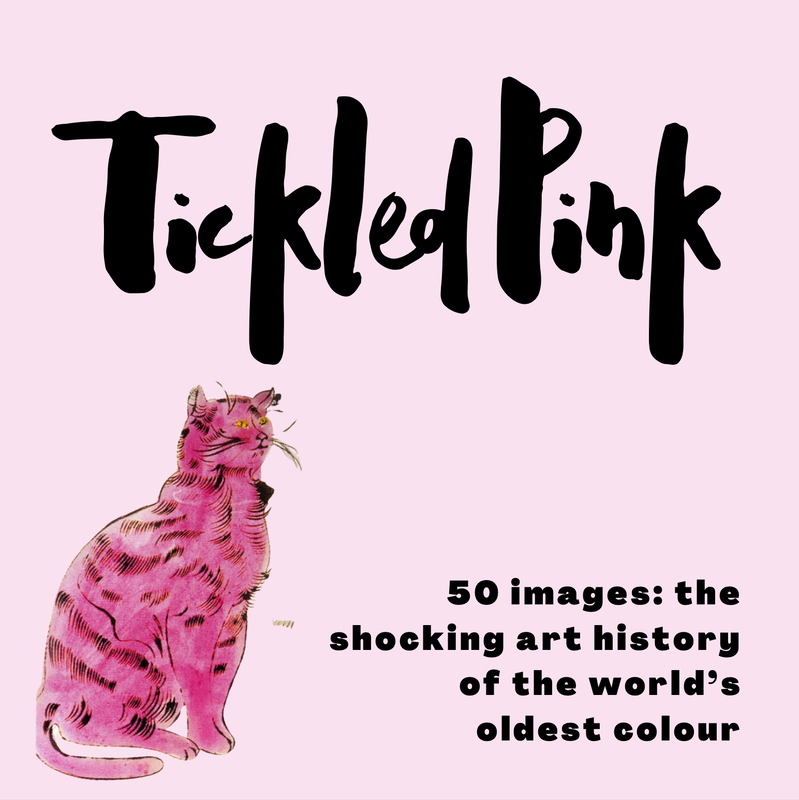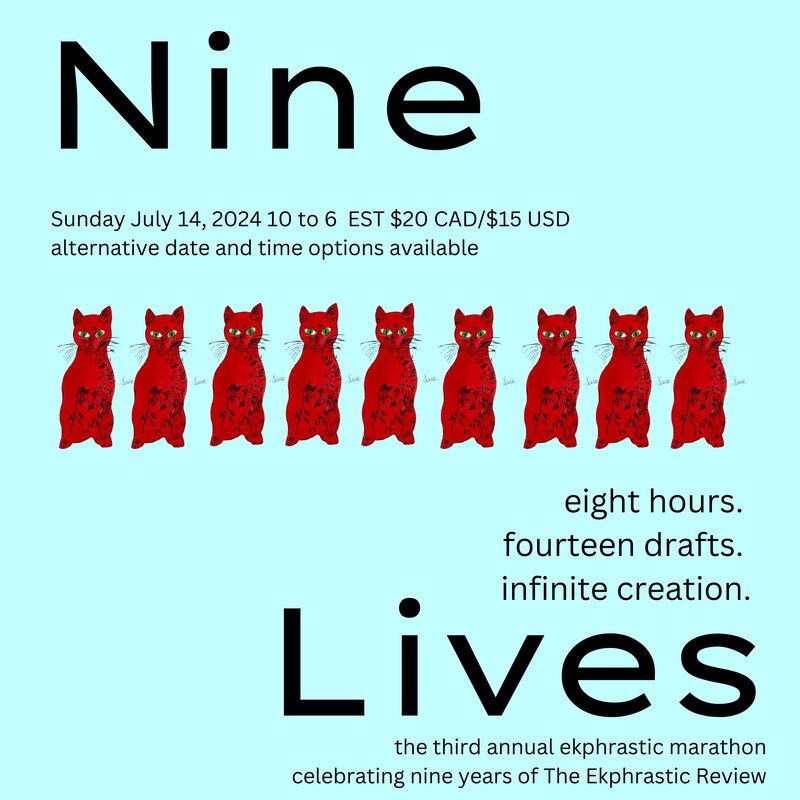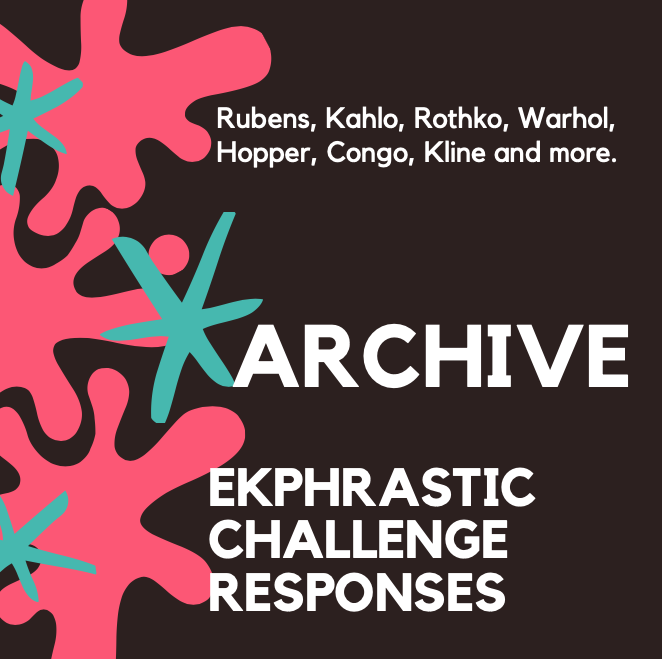|
Icon It’s your birthday, you solid-as-a-rock star; enjoy it out there, nowhere without end. You may have noticed our decline on YouTube and TikTok where every screenshot begs to be a forever sight, every video plays to go viral like the shepherd you heard of who found his sheep safe and asleep, or the woman who turned her house inside out to find a lost coin. We search for heroes in wild-goose chases through podcasts and blogs, hoping to land on an essential face, like yours, a face held in place firmly within a frame wide enough to keep meaning from spilling out, deep enough to hold hope in reserve, out of sight, below shoulders square and motionless in ancestral stillness, eyes pillowed in peace, oblivious to the wages of sin. Jeffrey Johnson Jeffrey Johnson: "The Russian Icon Museum in Clinton, Massachusetts is not far from my town. It's a gem of a museum. My new book of poems will be published this year by Fernwood Press."
1 Comment
Playwright’s Song I do my best writing in the New York matinee: standing far from the crowd, huddled deep in the corner of a spotlight-stained wall. Between the conversations that drift out of the mouths of strangers, I can create a life worthy of a curtain call: The first act would start beneath a green, fluorescent, glow where the smooth hum of saxophones lulls us in from the sidewalk. I’d sit in the corner, a glass of red swirling in my palm, until I’d see you reposition your tie, walk over, and let a joke fall from your lips as if it had been hanging on by a thread. A laugh would coat my throat like the sweetest remedy to this bitter wine and our hands would hang heavy in electrifying air until we were pulled by something into the streets, like two young kids being pulled into love by earths gravitational leash. The starlight would point out your face like recognizing an old friend and for one more moment I could pretend-- But even a writer can only bend the waiting reality so long, forcing the most beautiful fiction to memorize the words to her playwright’s song. Maddison Willigar Maddison Willigar is a college student living in Massachusetts who plans to attend Keene State University in the fall to obtain her bachelor’s degree in English. She spends her free time learning Greek mythology, American Sign Language, and escaping into the many books on her bookshelf. Endmatter The facts presented in the famous case of Valdemar were fictions after all, from Poe’s imagination. But a trace of truth remains amidst this blood and gall – the collapse of human body once released from life. Where is the spirit in decay? No soulstuff rises from this poor deceased, just liquid matter, festering away, loathsome putrescence, as the author wrote to end the story. There’s no comfort here, no afterword or illustrator’s note restoring hope. No respite from the fear. F.F. Teague F.F. Teague (Fliss) is a copyeditor/copywriter by day and a poet/composer come nightfall. She lives in Pittville, a suburb of Cheltenham (UK). Her poetry features regularly in the Spotlight of The HyperTexts; she has also been published by The Mighty, Snakeskin, The Ekphrastic Review, The Dirigible Balloon, Pulsebeat, Lighten Up Online and a local Morris dancing group. Other interests include art, film, and photography. Seeing Paul Nash at Tate Britain For you it was an earthly paradise; & that’s what matters. To imbue that spinney upon that clump or hillock with mystic properties, a circumambient ‘godliness’, was, undeniably, your prerogative. No-one could deny an artist such liberties, aesthetic or otherwise. A nation or culture creates its own divinities, or else it gets crash-landed. You’d seen enough of mustard-gas & air-raids, transportation in a cock-pit of immeasurable brush-colour, & light transcending the body’s manifold fragility. Vision is presence, a hushed ambience through leaves & branchwork. Art being noumenon of the regional: ubiquitous, unashamedly local. For you, cartography’s the truer eucharist, a contoured & petaled All-Heal spread out for the nations; &, ultimately, that's what matters. Mark Wilson Mark Wilson has published four poetry collections: Quartet For the End of Time (Editions du Zaporogue, 2011), Passio (Editions du Zaporogue, 2013), The Angel of History (Leaky Boot Press, 2013) and Illuminations (Leaky Boot Press, 2016). He is the author of a verse-drama, One Eucalyptus Seed, about the arrest and incarceration of Ezra Pound after World War Two, as well as a tragi-comedy, Arden. His poems and articles have appeared in: The Black Herald, The Shop, Tears in the Fence, 3:AM Magazine, International Times, The Fiend, Syncopation, Epignosis Quarterly, Dodging the Rain, Syncopation, Anvil Tongue, The Ekphrastic Review, Rasputin and Le Zaporogue. The Dancing Class In Repose surprised to sneak a peak of y’all in repose hands loosened necks stretched toes flattened Monsieur Perrot with the rats young company members he lurks like a hall monitor drunk with power y’all restrain from the break you crave one of release with abandon oh, to escape the pain toes numb limbs taught jaws immobile afraid monsieur will look your way pound his cane say YOU are not devoted to your art or is that a story you made up? take a note mimic the dancer with brown hair stage left a yellow bow at her waist confidence in the face of her fear close your eyes toss your own head back and you too scratch the itch below your shoulder soon the accompanist sits down feel the music learn your part no time to think of repose Jennifer B. Kahnweiler Jennifer B. Kahnweiler is a non-fiction author of 5 books and a poet who is based in Atlanta, GA. A favorite aunt gifted her with a book of Edna St. Vincent Millay’s poems and she was hooked. She started writing poems during the pandemic, and received the Natasha Trethewey poetry prize from the Atlanta Writers Club. She has been published in the Avalon Literary Review and MacQueen's Quinterly in recent months. Country Scene The sharp-focused photo shows a sunny day in the country long ago, and just yesterday. Memory recalls the tickle of tall grasses, smell of sweet clover, buzz of bees, hum of flies, the clear three-note call of the red-winged blackbird sitting on a rustic fence post connected to other posts by tightly-strung barbed wire. Beyond the fence, an abandoned farm beckons me to explore, to snoop. I want to pry open old latched barn door and peek inside the creaky, crooked outhouse. The fence wire feels cold, rough, dangerous when I lift it up to crawl under on my belly. I taste mud, ignore rip of snagged shirt and ouch of rusty scratch. Grass seeds cover my jean legs, wheat fleas circle my eyes and ears. I will go no further. It is too hot; too dusty; too risky. Sheryl Guterl Sheryl Guterl claims these titles: mother, grandmother, former English teacher, former elementary school counselor, Albuquerque Museum Docent, alto, bookworm. In the summer, she writes poetry from a New Hampshire cabin, surrounded by water, birds, tall pines, and campfire smoke. In the winter months, in New Mexico, lizards, sandhill cranes, and a rich cultural landscape inspire her. Sheryl’s recent poems are in Capsule Stories, The Bluebird Word, Clerestory, SLAB, Zephyr Review, and several local anthologies. The New Laocoön I don’t know whose bright idea it was to call it that. The original sculpture of Laocoön, the Trojan priest, and his two sons was recovered from the Baths of Trajan in 1506 and is now in the Vatican. It is one of those great works of art that is copied, re-copied and re-interpreted. However, the one I worked was not carved in marble, but made of plastinated, human tissue. Two sons, or at least two beautiful young men – no father – no priest. "Tony?" "Speaking." "Thought you were a man." "Toni with an eye: short for Antonia." "Steve told me to call you. Can you leave now?" "What's the problem?" I asked. "Steve said you did their feet." He could only mean the New Laocoön. “It’s in Geneva. At the Freeport.” It was not a professional job. The thieves had ram-charged the storage facility. The dumper truck was still lodged inside the remains of its fortified door. The gendarme on guard, stamped out his cigarette, looked at my legs and then waved us through. They had only looted the one security cage. I had no idea why. Art thieves are not the clever people you see in movies. Most contemporary works of art have impeccable provenance and are difficult to sell illegally. They are mobile assets, but not liquid. As for stealing on commission: serious crooks stick to paintings not biological works of art. The godfather would rather have a Renoir than a pickled shark any day. "Steve said you could help." The man who thought I was a man looked awful. He was facing a big insurance write-off. I got into biological fine art by accident. Post-doc, I made human, anatomical specimens for medical demonstration. The technique uses polymer to replace the fluid of natural tissue: the specimens do not decay. They turn into solid demonstration models. Anything from a tumor to a whole body can be turned into a sculptural object. A few artists took over the idea. The problem with pickling things in formaldehyde is that over time they lose color and definition. The pickling solution goes cloudy, too, and it can cause cancer. The New Laocoön (TNL) when first shown, was an immediate succès de scandale. Is it possible in the art world to succeed any other way these days? The naked, male bodies, suspended inside a vitrine, were locked in an amorous embrace. Two beautiful young men: two plastinated, human bodies with a graphite-like patina that turned them into classical sculpture. They had been real men, but who were they? Were they really lovers? How did they die? People kept asking the same questions. People kept coming to view the work, too. At one point, Interpol got involved: wanted to know if the bodies were legally sourced. But the Croatian artist wouldn't say. The French issued an arrest warrant. The artist went to ground, and TNL went to MoMA. Plastination is not a simple process. Let's say you want to make a medical model of a flayed human arm to show the muscles. After the skin is removed the arm is dehydrated, defatted, impregnated with polymer, and then cured. It takes a lot of time and care. In the case of the lovers the fresh bodies would have been molded into that famous embrace before being immersed in acetone. A couple of years ago I had repaired a small chip on the foot of one of two figures. I guess that is why Steve thought I was the person to call. "What do you think?" asked the insurance man. The thieves had broken open the packing case, smashed the vitrine with a hammer, severed the suspension wires, manhandled the two bodies to the ground, levered them apart and stolen one while leaving the other. Its right arm was snapped away at the head of the humerus. "Can it be restored?" What was the point, I thought, without the other figure? If I couldn't see the point Steve could. He was hopeful, I suppose, of tracking down the missing body and reuniting them both. He was not short of funds. The loss assurers were not too keen on writing it off either. A few million on restoration was better than forking out thirty to forty million in compensation. We rented a secure space within the Freeport, and I began fitting it out as a studio to handle the potential restoration. Meanwhile, I removed a flake of that wonderful patina material, and sent it to a friend in the Mauritshuis studio. We tried to contact the artist but got no response. Then a couple of days later we discovered through his London dealer that he had been murdered in Prague. A quarrelsome character, apparently: a bit like Caravaggio, I suppose. I went back to my own place in London for a few days. I had to complete a small job on a taxidermy exhibit by Tidemann. A couple of days after my return I had dinner with friends, then walked back alone over Battersea Bridge Road and down Prince of Wales Drive. It was late. It began to rain. I know that part of London well. I have had a studio there for years: a long time before speculators jacked the prices up. For some reason it suddenly felt unfamiliar. There was nobody about aside from a tall man on the opposite side of the road. I assumed it was a man. He seemed to glide along the shiny wet pavement keeping pace with my steps. When I got back, I gave myself a stiff drink and turned on the Mac to check the mail. There was a quick message from the Mauritshuis. They were still working on the patina recipe but had identified one of its ingredients as smalt. That was a bit of a surprise. Smalt is powdered glass colored with cobalt. They were already familiar with it, she wrote, because Rembrandt used it. It was I knew popular with painters in the sixteenth and seventeenth centuries. It adds a luminous zest to the painted surface, although it does not age too well. Although it was late, I decided to watch a movie on YouTube. I first watched ‘Der Golem’ at the old Electric Cinema in Notting Hill. It is a salubrious place now, but then it was home to stray cats and the lighting was very atmospheric. It all added to the mood of a silent, German, horror movie made in 1915. Watching it on YouTube was quite different. Set in the Jewish ghetto of sixteenth century Prague, the plot is complicated, but the golem is a clay monster animated by a written spell set in an amulet impressed into its breast. Anyway, I watched that for a bit, felt sleepy, finished my drink, turned out the lights and took a quick look through the window to see if it was still raining. It was, and I caught a glimpse of the same tall man. At least I think I did – best not to watch horror movies before going to bed. The next morning, I got a call from the insurance man. He had already been over to Prague. "Sounds nice," I said. "Not really." "No?" "Went to see his studio. You know. See if there's anything we can use." "Useful?" “There's lots of stuff including notebooks. Can you come over and see it?" “Not right now. I've got too much on.” "I'll send it to you in Geneva." "Is that OK with his agent?" I asked. But the phone went dead. Back in Geneva I set to work in earnest. The arm fracture at the head of the humerus revealed raw-looking splinters of plastinated bone, muscle, and skin. Somehow, I had to fit it back together again. The best plan, I thought, might be to grind down the splintered fractions to create a clean join. I could use a rigid, titanium pin. If that worked, I might use mortician's wax or wound filler. The insurance man had already sent me a good set of provenance photographs. If I had to free sculpt the arm, I did not want to get the position wrong. If ever we did recover the second lover, the refitted arm had to be a snug join around the upper back and shoulder of its companion. It made me think of the Discobolus in the British Museum. It is a Roman copy of a Greek bronze. The head was broken off and replaced by a restorer the wrong way around. Instead of looking at his discus the athletic thrower has a brilliant view of his own knees. Restoration is always a mixture of art and science. I would have to think very carefully about the arm. In the meantime, I could check the rest of the figure. The best idea, the logical way of doing it, I thought, was to set myself a daily schedule of looking at things detail by detail. After making the schedule, I decided to turn in for the night. Our temporary studio was a tent-like structure of transparent polythene sheeting in the middle of the small hangar we had rented. The hangar itself was air-conditioned and a filter kept the tent dust free. The body rested on a foam mattress on a dissection table and was covered with a clean cotton sheet. I had a surgical lighting system set up. It was a neat arrangement. Seen from outside, the tent looked like a huge, glowing cube of ice. The electrics came via a switch box at a side entrance to the hangar. I tidied up the photographs on the righthand side of the dissecting table next to the intact, left arm, and tugged the sheet over the body. I left the ice cube, hit the switch by the door, unlocked the door, let myself out and then re-locked it. The following day I had a late start. I took breakfast in my hotel and read the papers rather than my laptop. I saw that another work by The New Laocoön artist had done well at Christie's, New York. A record price, it said. Not much use to its late creator, I thought, but then artists who do so-so in life sometimes do well in death. I kept puzzling over the right arm repair. There was no way I could do it without the other body unless the owner decided to restore it as a single piece. I took a taxi from the hotel out to the airport. On arrival I went through the rigmarole of checking in, unlocked the hangar, hit the power switch, and prepared to start on my checklist. When I stepped into the ice cube, I had a feeling that something was amiss. I looked around. Everything seemed OK. I sometimes get strange feelings when working alone. However, I turned on the Mac, printed off my checklist, put on my surgical gloves and went to remove the covering sheet. The tip of one of the fingers of the left arm peeped out from under the sheet. It rested on the stack of provenance photographs, and the top photograph showed the face of the missing figure. I was stunned. I was sure I'd covered it up. Perhaps the photograph had slithered off the pile and under its finger. My phone rang. "You, OK?" "Fine, " I said. "We got quite a lot of stuff from Prague. Production notes and so on." "Right." "On its way." "Right." "I'll be over next week. Got a meeting with Steve." "Any luck with the other figure?” I asked. But he'd already gone. So, the agent didn't mind our borrowing his dead client's notebooks, but then he probably had an eye on their eventual auction. If they turned out to be useful in a forensics case, it would make them more attractive at auction. However, while going over the body, I found something not included in the provenance notes. There was a significant wound over the abdominal aorta. Since the artist had applied the patina after the figures were fixed, those parts of the chest and abdomen not visible in the finished work were in their usual, raw, plastinated condition. Furthermore, the artist or someone else had made a tissue repair before plastination. When I probed the wound a plug came loose. It filled what looked like a puncture wound and had an odd composition. Although plastinated, like everything else, it was a tightly rolled piece of something: perhaps animal parchment. It occurred to me that it might even be human parchment. Anyway, I took a photograph and emailed a JPG to someone I knew in forensics. When you work in my line, most people you know are in the death and resurrection business. I placed the plug in a kidney dish on my instruments trolley. And aside from the wound and humerus fracture, the rest of the cadaver looked fairly all right. A couple of days later a small crate of stuff arrived from Prague. I set up two wooden trestle tables outside the ice cube and started to arrange the contents. There were over a hundred drawings and scribbles, but none dealing directly with TNL. I was lucky with the notebooks because one dealt with prepping the bodies. Both men died, the notebook suggested, from ballistic trauma. That was puzzling because there was no evidence of that on the body I was looking at. The background story seemed to be that the two men died trying to save one another. They were lovers who had found themselves on opposite sides in some ethnic conflict – so the artist said. When I spoke to the insurance man again, he suggested the Bosnian War. "Why Bosnia?" "Dates, really. It was in circulation by ‘97, wasn't it? And then it was in that French show in 2000. The Bosnian war was ninety-two to ninety-five, wasn't it?" There was talk of a major retrospective. Wouldn't it be great, Steve's agent said, if TNL was ready for that? I dare say it would, but the other body was still missing, and I had done as much as I could in the meantime. I went back to London for Christmas and was going to take a short holiday afterwards when I got a call early in January. "You'd better get back here. We've found it." It was big news. You may recall it. The thieves were not international villains. They were family relatives of the dead man. Scandalized by his use in a profane work of art as they saw it, they decided to recover his body and give it a proper burial. The other body was of no interest to them. It was true that the two men had been lovers. That had outraged the family, too. The lovers were of different religions, came from different ethnic groups, and were gay. They made a great work of art and caused a great deal of personal distress. As a piece of sculpture, they were, as I said, a succès de scandale but one of the men, at least, was a disappointment and source of abiding grief to his family. Exhuming the body from its new grave and returning it to Geneva was a diplomatic and logistical nightmare, and fortunately I had no part in it. The insurance man was not really forthcoming on the matter, and I suspect it cost him plenty. As I said, he was facing a bill of forty million, so a million here or there was not that important. Given the storyline, once TNL was properly restored and passed through a couple of blockbuster shows, it might well double in value. Scandal, murder, and theft always jack up the prices. The agent chartered a jet, and the body came back in style. A pack of news hounds recorded the off-loading of the coffin. Steve came over from New York for five minutes and gave an interview about its artistic importance. It was a worldwide icon of the gay community and so on. I kept out of the way. Full restoration of the piece was not a foregone conclusion. I did not want to answer any awkward questions, but the agent arranged a photo-op for a chosen, few inside the hangar. I tried to keep my comments short, and after we opened the coffin for photos we locked the place down again. Steve dropped in, shook my hand, told me he was relying on me, and shot off to New York again. In the eerie silence following all the fuss, the agent and I sat on a couple of chairs by the coffin. It was propped on stout, steel trestles. A second table had already been delivered to take the recovered body, and I placed it to the right of the first. When I eventually joined them together again, I would need to bolt the tables together. But that was a long way off. Restoring each of them separately would take a while. "What do you think?", he asked. "We'll see," I said. "Steve is relying on you. We're thinking of a special exhibition next year." "Are you?" "You, OK?" "Fine. Give me a hand, will you?" "What?" "I need to shift him to that table. Use a pair of these gloves." "Me?" "Can't see anyone else, can you?" Even after a couple of weeks, the spooked feeling did not go away. The body had been washed and shrouded preparatory to its burial, and the washing had removed much of the patina. I would need to make good the plastinated tissues, rejoin the bodies and re-polish them. It was going to be a long job. While inspecting the second body I was also considering the possibility of taking on an assistant. On the plus side, the second body was not too damaged except in the abdominal area where the thieves, where the family, had levered apart the two bodies. The plug of whatever it was, I now saw, fitted inside their conjoined bodies. With my back to the first body, while inspecting the second, I eased back my wheeled chair to get a better view of the abdomen. The two bodies on their separate tables lay side by side with me in between. As I moved back and tried to better angle the inspection lamp, I bumped the table behind me. It was a fairly gentle tap but sufficient to dislodge the body and roll it sideways. Since there was no right arm to stop it, the next thing I knew was that its intact left arm was reaching across my shoulder towards the second body. I shot out of my chair, a stupid reaction, and the reaching body would have fallen had its hand not come to rest on the arm of the second body. I took a couple of days off after that and ignored the phone. The agent was now in the habit of calling every day. "How was it going?" "When would I finish?" Steve had been talking to Larry and they were keen to get the TNL back on show. I did finally answer one of his calls. "I need an assistant," I told him. "You, tell me. Anything you like." "I'm not sure who." "Whoever." The truth was I needed live human company. It was my contact at the Mauritshuis who suggested Lucy. She had just finished an art conservation degree. She was very good, my contact said. Could certainly help with the re-patination. Would jump at the chance to work with me. Would jump through fire to work on The New Laocoön. Well, she did not have to jump through fire she just had to join me in Le Freeport in a hurry. Six months later we were ready to reunite the lovers. Steve was pleased, Larry was pleased, the agent was crunching numbers in New York, and Lucy, standing in one corner of the ice cube, was holding the detached arm. We had an approximate angle for its fixation, and she had come up with the brilliant idea of using a flexible, spring-like connection rod. After rejoining the bodies, we could manipulate and lock the encircling arm in place with adhesive and use filler to free sculpt the deltoid fracture. The Mauritshuis had also come up with something approximating a workable patina recipe. Temporarily, the two bodies lay side by side under an electric hoist with their two tables bolted together. Lucy placed the arm with its flexible pin next to its owner. Final fixation and rebuilding could be done after we reunited the lovers. We stood back, admired our handiwork, and decided to call it a day. A little sleep, a little slumber, a little folding of the hands, and I was wide-awake again. The job was still complicated, and I was going over potential problems. I got up at five, took a shower and then set off by taxi. I left a message with the night clerk for Lucy. Said I would see her whenever she was ready to join me during the morning. Dawn was breaking when I arrived. I went through the usual rigmarole of checking in and then unlocked the door. As I reached for the light box inside, I heard a noise. It was a voice. No, voices. Not talking. My first thought was that someone had sneaked in, but how? There it was again. I flipped the switch. There was movement inside the ice cube. The two bodies, in an embrace, were moving to and fro. I stepped back and hammered on the door to get out. I then realized that all I had to do was open it. I returned to the hotel and was hurrying across the entrance lobby when I met Lucy. "You're up early," she said. I nodded. "You, OK?" The day clerk came across and gave her my note. She took a quick look. "You left early." "Just got back," I said. "Problem?" "Felt a bit spooky on my own," I said. So, I came back. Shall we go?" "Soon as I've had breakfast," Lucy replied. Back in my room I took another shower, ordered coffee from room service, tipped in a miniature of whisky from the icebox and sat down to check my email. The coffee plus the whisky calmed me down. What an idiot I was. "Thanks for photos – difficult to say without seeing artifact – like you said looks like roll of parchment – tried magnifying the writing – see file. Best K." I had not noticed any writing on the roll of parchment, but if so, plastination would not necessarily erase the ink pigment. I must look at the thing again when we got back. It was still in the steel kidney dish on my instrument trolley. I gave Lucy the key. She entered first, pushed back the polythene sheeting and entered the ice cube. "Thought you said you were here just a few minutes," she said. I joined her. The two bodies, all arms, were reunited in their famous embrace. "Looks good," she said. Then I remembered the scroll thing and looked at the instrument tray. It was gone. My phone rang. I asked Lucy to take it while I took a closer look. "Hum. Yes. She's here." I waved my hands to say I was busy. "Bit busy. Yeah. We got them back together again. Toni did it this morning." She rang off. "Mr. Insurance man." "Who else?" "Take a close look at his arm." I said. "Sure." She examined the fixed arm more closely. "You got it just right," she said. "A really lovely job." Wilf Tilley Wilf Tilley is a neurophysiologist, artist and writer living and working in Tokyo. Read another story by Wilf Tilley at The Ekphrastic Review. Night In Pink Satin The evening was awash in sweet, sneak-up-on-you Cosmos, of bodies colliding and sliding near and around each other. Eduardo emerged with all these sensations in his bleary half-awake brain. He was sure of one thing. He’d arrived at Randy’s party fully dressed, a golden cucumber dangling from one ear, hair in a flirty ponytail and lips pomegranate juicy red. Truth be told, though, he was still nursing a bit of heartbreak and he’d only agreed to go because dear ravishing Randy promised it would cure what ailed him. But he can’t remember how the high heels got on his feet, how his fitted, pinstriped Gucci suit was replaced with sumptuous silken streamers, how his lipstick had smeared deliciously onto his neck and muscled chest. He tried to hold onto the hints of maraschino and cotton candy tantalizing his tongue, of images and sensations that had begun to fade and gray as he entered the conscious world and the sun intruded through the gap in his blackout shades. But still… There was the sense of a wolf with a man’s body or a man in a wolf suit licking his thighs, his chest, chewing delicately here and there as he struggled to remain passive, covering his arousal with a gorgeous peach satin number, pretending to focus on the buoyant clouds that floated him near the hole in the aurora borealis sky salted with stars and peppered with tiny, naughty love creatures. And Randy. Floating by in zebra stripes and feathers as Eduardo tried to grip his hand that kept slipping like those streamers sliding off slick skin. And those commanding, terrible winged beasts with beaks of amber and taut, roseate buttocks flying around with—was it ill intent or erotic promise? He sensed them lobbing rainbows across the sky like the offerings of some prismatic deity, but also tossing a scalding sun—a persimmon beachball—whose heat would burn your delicate skin if it orbited too close. Eduardo patted the far side of the bed half expecting his hand to land on Randy’s thigh or chest, but found only crumpled sheets. Had he even been here? Eduardo hugged his plump pillow close, trying to hold on to last night’s sweet, strange, bawdy pleasures in the darkened solitude of his loft apartment for as long as he could. Kathryn Silver-Hajo Kathryn Silver-Hajo is a 2023 Pushcart Prize, Best Small Fictions, and Best American Food Writing nominee whose flash fiction, CNF, and poetry has been published in many lovely journals and included in a number of anthologies. Her novel, Roots of the Banyan Tree is forthcoming in fall 2023 from Juventud Press. Kathryn lives in Providence, Rhode Island with her husband and curly-tailed pup. More at kathrynsilverhajo.com/ twitter.com/KSilverHajo and instagram.com/kathrynsilverhajo/ Tint My mother dyed her hair − I was adopted that next day − processed, approved by all, made-to-order with Dad's red hair. Saturday nights, I watched her bend above a basin soaking red tints into gray, rinsing away the lack of 50’s perfection. Dad displayed me to friends and family, a boy to teach all he knew. She rocked me through twilight with lullabies, making me her own. Their first child had died, born blue and silent. Number two was sponged away. Determined to improvise, My mother dyed her hair − immersing each strand in auburn tints, hoping to look the part. As I grew, teenage pastimes replaced her. My father discovered electric trains, or took me fishing. Through attrition, we abandoned her. The gambit fell apart, leaving another shadow to cradle. Her hair found truer colour. Toward the end, strokes and strike outs paled her prayers. I wrapped myself in the quilt she never started, as my orphan's life began again. Masques for Maternity My mother’s first child was stillborn. Limp amid the ward's cries and coos. Among mothers in suckling’s glow. In private rooms of pastel walls. Balloons, small bears, Neapolitan ice cream – celebration’s trifecta. Sitting up, overdressed in a pink robe, she disregards intercom incursions. Terse intention of the night-intern – slight improvisation in meds to lull this hell, or a new sun's torment. Blood in the bedpan. Breastmilk dribbled down the white basin. ** Hospital intercom opera disorients. Surreal prognosis serenades an unfamiliar tune. In the hall, a brash food service cart crashes past the elevator door. Rattles the aria’s delight. Thumping wheel measures tile, then carpet. Then tile. Then clatter. Where's the discharge nurse? Release aftershock as a dove a-flight. Defeated answers when silence swells – divination dispels like a snowflake melts on the tongue. No reconciliation for a heart. Pre-dawn coffee now cold. Wind outside in moonglow. The life-machines' crescendo. Awkward final act at a whole note rest, like quiet softens without ovation. ** Our single kiss. Your salt etches my lips, taste buds left thirsting – bitterness dries any bloom. A sprout becomes expanse of shed petals. Weariness grafts us like initials crudely carved into bark: green symbols surrounded by dark crust. Our dislodged embrace an axiom. Our moment a prop for a dusty bookshelf cluttered with wishes and fresh toys. Notebook with ribboned pages – weary scribbles, opaque rage – cursive scolding for flat-lined love. Morgued. No revival except by my own foul breath. Our loose hug a simple pose beneath delivery room florescent glare. Raincloud sky proffers drizzle over this ache as I spin robust red wine in the rosewood rack. Sam Barbee "Tint" first appeared in Sam's book, That Rain We Needed (2016, Press 53). Sam Barbee has a new poetry collection, Apertures of Voluptuous Force (2022, Redhawk Publishing). He has three previous collections, including That Rain We Needed (2016, Press 53), a nominee for the Roanoke-Chowan Award as one of North Carolina’s best poetry collections of 2016. Also, Uncommon Book of Prayer (2021, Main Street Rag) which chronicles family travels in England. His poems appeared recently in Salvation South, Dead Mule School, Asheville Poetry Review, and Adelaide Literary Magazine, among others; plus on-line journals American Diversity Report, Verse Virtual, The Voices Project, and Grand Little Things. He is a two-time Pushcart nominee. Lucky 8: an Ekphrastic Marathon Try something intense and unusual- an ekphrastic marathon, celebrating eight years of The Ekphrastic Review Join us on Sunday, July 16, 2022 for our second annual ekphrastic marathon. This is an all day creative writing event that we do independently, together. Take the plunge and see what happens! Write to fourteen different prompts, poetry or flash fiction, in thirty minute drafts. There will be a wide variety of visual art prompts posted at the start of the marathon. You will choose a new one every 30 minutes and try writing a draft, just to see what you can create when pushed outside of your comfort zone. We will gather in a specially created Facebook page for prompts, to chat with each other, and support each other. Time zone or date conflicts? No problem. Page will stay open afterwards. Participate when you can, before the deadline for submission. The honour system is in effect- thirty minute drafts per prompt, fourteen prompts. Participants can do the eight hour marathon in one or two sessions at another time and date within the deadline for submissions (July 31, 2023). Polish and edit your best pieces later, then submit five for possible publication on the Ekphrastic site. One poem and one flash will win $100 each. Last year this event was a smashing success with hundreds of poems and stories written. Let's smash last year out of the park and do it even better this year! Marathon: Sunday July 16, from 10 am to 6 pm EST (including breaks) (For those who can’t make it during those times, any hours that work for you are fine. For those who can’t join us on July 16, catch up at a better time for you in one or two sessions only, as outlined above.) Story and poetry deadline: July 31, 2023 Up to five works of poetry or flash fiction or a mix, works started during marathon and polished later. 500 words max, per piece. Please include a brief bio, 75 words or less Participation is $20 CAD (approx. 15 USD). Thank you very much for your support of the operations, maintenance, and promotion of The Ekphrastic Review, and the prizes to winning authors. Selections for showcase and winning entries announced sometime in September. Sign up below! Lucky 8 Ekphrastic Marathon
CA$20.00
An all day ekphrastic marathon on Sunday July 16, 2023, celebrating eight years of The Ekphrastic Review. Eight hours, fourteen drafts. Polish drafts later and submit your five favourites! Poetry and flash fiction. Marathon will be held in a private Facebook group with multiple prompts to choose from, one every thirty minutes. If date or time zone don't work for you, we have alternative participation options! |
The Ekphrastic Review
COOKIES/PRIVACY
This site uses cookies to deliver your best navigation experience this time and next. Continuing here means you consent to cookies. Thank you. Join us on Facebook:
Tickled Pink Contest
April 2024
|
